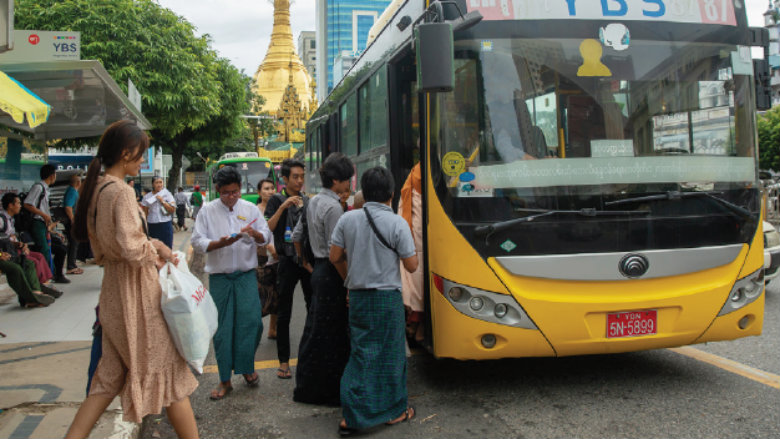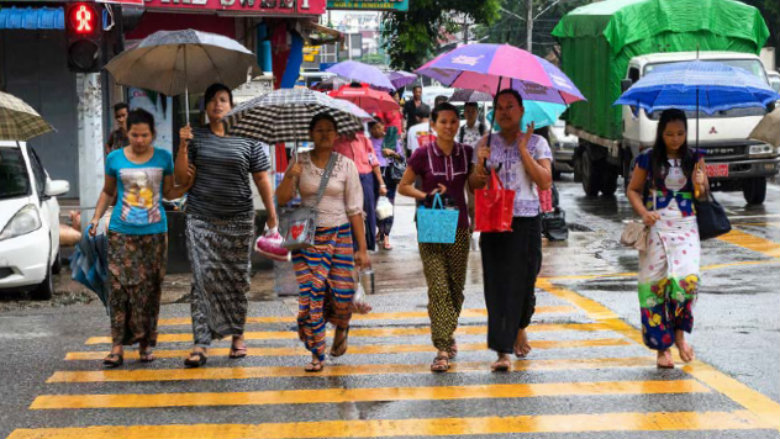Context
Urban growth, while offering opportunities for economic development and creation of more and better-paid jobs, also increases the pressure on the existing urban mobility systems and access of the population to jobs, services, and their communities.
Yangon, with over 5 million urban population, is the main economic center in Myanmar. Restrictions on motorcycles and bicycles have severely limited the use of these two-wheeler modes in Yangon City. This has particularly helped maintain a healthy demand for public transport, predominantly by bus which account for about half of trips, excluding walking. At the same time, motorization has increased almost threefold during 2010–2017. Traffic congestion has emerged as an urgent challenge.
Mandalay is the second-largest city in Myanmar and has about 2.1 million urban population. Mandalay, once a city of bicycles, is now host to over a million motorbikes, making it the region with the highest number of total registered motor vehicles in Myanmar. In the absence of a functioning and efficient public transport system, Mandalay is expected to continue registering motorcycles at a high rate, further leading to consolidate the dominance of motorbikes over any other transport mode.
Urban mobility challenges in both cities will only become more sophisticated and costlier, and addressing these challenges sustainably and efficiently will increasingly require integrated policy solutions, stronger technical capacity, and efficient use of resources. A forward-looking, actionable, and financially viable strategy for urban mobility is a fundamental component to support sustainable and inclusive urbanization in Yangon and Mandalay.

Key messages and policy recommendations
Urban Transport Institutions and policy
- In Yangon, the public transport agenda has taken an important role with the establishment of the Yangon Regional Transport Authority (YRTA) in 2016. As part of reforms of the bus system, an updated bus network and service scheme branded under the Yangon Bus Services (YBS) began operations in 2017, effectively improving the quality of public transport services. Further strengthening of the institutional framework is needed to support financially viable plans for better urban mobility systems. The Yangon Region could consider supporting YRTA’s higher-level strategic planning activities by establishing a Yangon Urban Mobility Board, composed of delegates from respective union and subnational authorities.
- Mandalay, with no formally defined urban transport institutional framework, suffers from a lack of coordination leaving multijurisdictional functions such as urban transport management and planning without real owners. Mandalay could advance in policy and action that allow establishing the Mandalay Regional Transport Authority, which should gradually build technical capacity that will enable it to coordinate the development and implementation of urban transport strategies and policies as a lead agency.
- Both Yangon and Mandalay have the potential to make their transport systems more inclusive. It requires both policy-level actions through understanding specific mobility needs of excluded/vulnerable groups and integrating this analysis into urban transport policies and plans as well as financing to support the development of inclusive urban transport infrastructure and services that would equitable serve all groups in society.
- Yangon and Mandalay are also recommended to prioritize digital infrastructure to leapfrog and transform itself into a smart city to overcome the current lack of accurate and reliable transport and urban data.
Urban transport financing and expenditures
- Under regular circumstances, ticket revenues allow bus operating companies in Yangon to cover operating costs, but not enough to cover financing costs for capital expenditures, including fleet upgrades. The financial performance of the majority of the bus operators remains weak, and their short-term liquidity and medium-term solvency is questioned as passenger ridership levels are likely to be limited as part of social distancing policies related to COVID-19.
- Myanmar Railways is implementing an investment program to modernize the Yangon Circular Railway and keen on redeveloping land around stations following Transit-Oriented Development. The complexities around urban rail-guided upgrading should be accompanied by policy and administrative reforms to improve the technical and financial performance of Myanmar Railways.
- The review of public expenditures indicates that the actual public spending levels in urban transport is not enough to meet the high demand for transport service delivery. Alongside increases in expenditure on urban transport in the medium term, efficiency improvements will be required to budgeting and public investment management.
- The experience in urban transport PPPs is limited in Myanmar. Given the importance of management of fiscal and technical risks, the role of the union government is important to support Yangon and Mandalay in the identification and preparation of viable PPPs in urban transport sector.
Urban transport funding
- Modernization of urban transport infrastructure and service requires dedicated revenue streams that are relatively stable and predictable over the long term. Two cities would benefit from developing resource mobilization plans for the urban transport system. Such plans can review types of instruments in place to finance and fund different urban transport system components and analyze them from the perspective of revenue level, financial, and transport sustainability.
- Yangon and Mandalay could start with mobilizing funding for urban transport through existing funding instruments such as wheel tax, parking charges, and property tax and use it for immediate needs related to public transport. High-level estimations indicate that Yangon has potential to generate over US$1.8 billion and Mandalay US$1.3 billion between 2020 and 2035 with the existing funding instruments. In addition, new instruments can be potentially considered with detailed prior due diligence to assess risks and minimize negative impact on the poor and vulnerable groups.
Note: The study has been co-funded by the Mobility and Logistics Multidonor Trust Fund (MOLO), managed by the World Bank Group and supported by the Governments of Switzerland (SECO), Germany (BMZ), and Austria (BMF). The World Bank thanks in particular SECO for its support to this activity.
